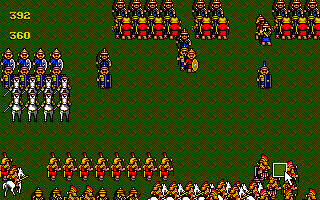Retro Replay Review
Gameplay
Fighting for Rome delivers a robust real-time tactical experience that places you in command of Roman legions on diverse battlefields. From the outset, you choose your army’s composition—foot soldiers, archers, and cavalry—tailoring each force to your preferred strategy. The three distinct terrain maps, ranging from rugged hills to open plains and dense forests, demand adaptive tactics and encourage varied approaches to flanking, ambush, and defense.
(HEY YOU!! We hope you enjoy! We try not to run ads. So basically, this is a very expensive hobby running this site. Please consider joining us for updates, forums, and more. Network w/ us to make some cash or friends while retro gaming, and you can win some free retro games for posting. Okay, carry on 👍)
Pausing the action to issue orders is a cornerstone of the gameplay. This feature ensures that even complex maneuvers—such as coordinating cavalry charges while repositioning archers for volley fire—can be executed with precision. As battles escalate, the ability to freeze time keeps the pace manageable, allowing both veteran strategists and newcomers to issue commands without feeling overwhelmed by simultaneous engagements.
Generals in Fighting for Rome have unique rally abilities that can turn the tide of battle. Whether boosting morale in the face of a cavalry onslaught or reinforcing wavering lines of infantry, these rally effects add depth to each encounter. Deploying this mechanic at critical moments becomes a test of timing and foresight, rewarding players who study enemy movements and anticipate weak points.
Graphics
Visually, Fighting for Rome strikes a balance between historical authenticity and tactical clarity. Units are rendered with enough detail to distinguish legionaries’ armor, archers’ bows, and the graceful sweeps of mounted cavalry. While not hyper-realistic, the art style remains coherent and evocative of ancient Roman warfare, immersing you in the era’s ambiance without sacrificing readability on the battlefield.
The three terrain maps each boast a distinct palette and environmental features. The hilly map offers craggy outcrops and shaded valleys, the plains are bright and open with rolling grasses, and the forest map is rich in foliage and hidden chokepoints. These visual distinctions are not merely cosmetic—they inform your tactical choices, making it easy to recognize cover, elevation advantages, and natural obstacles at a glance.
The user interface complements the battlefield views by remaining clear and unobtrusive. Health bars, unit icons, and command menus sit along the screen’s edges without blocking the action. Subtle animations—such as the glint of steel or the flutter of a standards flag—bring battles to life, while the camera controls allow you to zoom in for detail or zoom out for strategic overview.
Story
Although Fighting for Rome is primarily a tactical war game, it weaves in a light but engaging historical narrative. You assume the role of a newly appointed Roman general tasked with securing key territories for the burgeoning empire. Each of the three terrain maps represents a campaign theater, complete with objectives like holding a mountain pass or breaking an enemy siege.
Between battles, brief text vignettes and map-based cutscenes set the stage for upcoming engagements. These narrative interludes recount the stakes—be it quelling a barbarian incursion or reinforcing a besieged colony—and provide context for the next tactical challenge. While not as deep as a fully voiced campaign, these story beats give your victories and defeats a sense of purpose.
The melding of history and strategy fosters an educational undercurrent. Players pick up snippets of Roman military structure, unit roles, and battlefield customs as they progress. This subtle infusion of background lore enhances immersion, making each maneuver feel grounded in the realities of ancient warfare rather than abstract skirmishes.
Overall Experience
Fighting for Rome shines as a focused, accessible tactical game that rewards planning and adaptability. Its pause-and-command system ensures that no battle feels unwieldy, and the rally mechanic injects thrilling comebacks into even the most dire engagements. Whether you prefer methodical infantry formations or daring cavalry sweeps, the game caters to multiple playstyles.
Graphically, the title hits the sweet spot between clarity and charm. While not pushing the envelope in photorealism, its consistent art direction and distinctive terrain maps keep the battlefield visually engaging. The streamlined UI and responsive controls further contribute to a smooth gameplay loop that novice and seasoned strategists alike can appreciate.
Although the narrative is relatively concise, it provides enough context to motivate your campaigns and gives historical flavor to each clash. Combined with varied map designs and customizable armies, Fighting for Rome offers strong replay value. For anyone intrigued by Roman military history or seeking a solid real-time tactics experience, this title is well worth your attention.
 Retro Replay Retro Replay gaming reviews, news, emulation, geek stuff and more!
Retro Replay Retro Replay gaming reviews, news, emulation, geek stuff and more!









Reviews
There are no reviews yet.